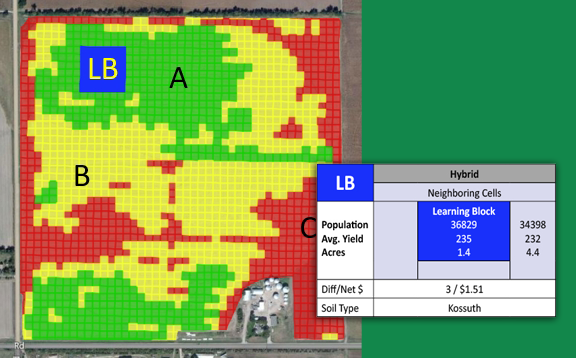Some people remember phone numbers or slender dates; I remember farm fields. Before the 2005 crop year, the program leaders for Central Advantage from Central Valley Cooperative in southern Minnesota asked me to help generate variable-rate planting prescriptions. The primary question was “agronomically, what makes sense?”
Field by field, I looked at the data collected for historic yields, soils, fertility levels, cation-exchange capacities, etc., and generated variable-rate prescriptions for each field. But I didn’t stop there. I wanted to prove that what I thought made sense agronomically would truly work.
To do so, I put 1- to 2-acre check blocks within each area/population rate of the field. That fall, I carved out the yield for each acre check block and compared it to its surrounding area. I still remember those fields and the stories the check blocks told as we learned and proved concepts.
Since those days, we [Premier Crop] have trademarked the name Learning Blocks™ and have automated the process for analyzing yields inside Learning Blocks compared to the surrounding area via planting, fertilizer and other inputs. In my entire career I have never “sold” anything as popular as Learning Blocks! Growers love them for many reasons. Most notably, they make sense – comparing 2 treated acres to 4 non-treated acres within a management zone is a great apples-to-apples comparison. And, the technology does all the work – the grower does not need to slow down planting or harvesting to learn from the data.

Growers enjoy not being told “trust us, this recommendation works”; but rather are given the ability to check and validate the recommendation. In the case of planting, growers can see Learning Blocks by downloading them into their smartphone and physically walking to a Learning Block, verifying the population change. Learning Blocks area low-risk strategy for implementing changes. For example, planting 39,000 plants per acre or increasing nutrient rates across an entire management zone might be a stretch, but every grower would risk a 2-acre Learning Block to test the limits.
Premier Crop has done plenty of strip trials in the past – running different across the entire length of a field. For variable population, the strip trial approach means running high populations across all management zones. Everything we gained from increasing populations in an A zone, we lost when the strip ran across a C zone.
When premier Crop talks about using data to make decisions, Learning Blocks are a vital part of that decision-making strategy. They give growers the knowledge necessary to refine further the prescriptions in their fields, with confidence and data to back them up.
